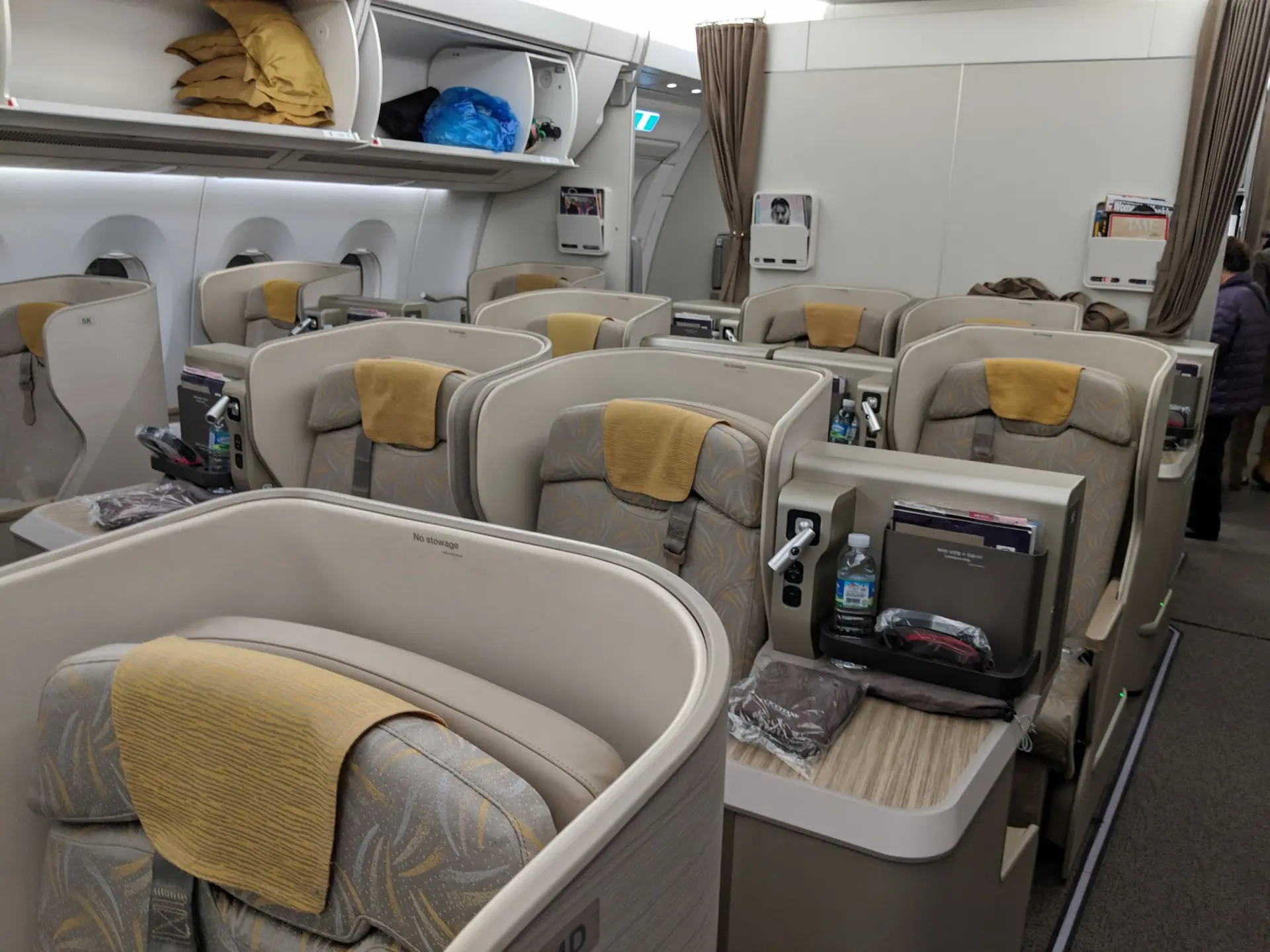As someone who has spent thousands of hours in the air across dozens of carriers, I’ve come to appreciate airlines that strike the right balance between comfort, consistency, and value. Asiana Airlines, South Korea’s second-largest carrier, has always stood out to me as a quiet performer,less flashy than its sibling Korean Air, but often more refined in key areas.
I’ve flown Asiana Business Class multiple times across long-haul and regional routes. In this review, I’ll give you a complete rundown of what to expect in the seat, service, food, amenities, and the lounge experience,and whether it’s really worth the price or your hard-earned miles.
What Aircraft Does Asiana Use for Business Class?
Asiana’s long-haul Business Class product varies significantly depending on the aircraft:
- Airbus A350-900: 1-2-1 layout, staggered seats, newer cabin
- Boeing 777-200ER: 1-2-1 flat-bed seats (older but spacious)
- Airbus A380-800: 1-2-1 on the upper deck (fewer active routes)
- Regional aircraft (A330, A321): 2-2-2, angled lie-flat or recliner
If I had to choose, I’d go for the A350 every time,modern cabin, efficient design, and more tech. The 777-200s are still comfortable but starting to feel a bit dated.
How Comfortable Are the Seats in Asiana Business Class?
Seat Configuration
On the A350, Asiana uses staggered flat-bed seats in a 1-2-1 layout. This means:
- Every passenger has direct aisle access
- Seats alternate between being closer to the aisle and window
- Privacy varies depending on seat position
On the 777, it’s an older design but still a true flat-bed, with wide seats (around 22 inches) and good pitch (75–80 inches). There’s no sliding door or suite enclosure, but the layout is functional.
Bed Comfort and Sleep Quality
Once reclined, the seat turns into a fully flat bed, long enough for my 6’1” frame. Asiana provides:
- A mattress pad (thin, but better than nothing)
- A thick blanket and proper pillow
- Eye mask and slippers
Cabin temperatures remained cool and consistent throughout the flight, and noise was minimal on the A350. I slept for nearly 7 hours uninterrupted,helped by the angled privacy of the window seat.
How Is the Onboard Service?
Asiana’s flight attendants are, without exaggeration, some of the most professional and courteous in the industry. There’s a kind of polished calmness to the way they work,never rushed, never robotic. The crew usually greets each Business Class passenger by name and offers a welcome drink,typically juice or water, but Champagne is available if you ask.
The level of attentiveness is excellent without being intrusive. During meals, they check in frequently but discreetly. When I once asked to skip the appetizer and move straight to the main course due to fatigue, the crew adapted without hesitation and even plated the dessert early so I could sleep right after.
Cabin service is often bilingual (Korean and English), and instructions are always delivered with clarity and grace. Even on shorter regional flights, the formality and consistency of the service never slip.
What’s the Food Like in Asiana Business Class?
The inflight dining experience is one of Asiana’s strong points. The airline offers both Korean and Western menu options, and they’re consistently well-prepared, even at 35,000 feet.
On a recent flight from Seoul to Los Angeles, I chose the Korean meal. It started with a marinated octopus salad and was followed by a stunning bibimbap,served with hot rice, minced beef, seasonal vegetables, and gochujang (Korean chili paste) on the side. A seaweed soup and Korean side dishes (banchan) rounded out the meal. Everything was fresh, well-seasoned, and properly presented.
Western meals usually include dishes like seared beef tenderloin or grilled fish with seasonal vegetables, a salad, and a dessert. The plating isn’t extravagant, but the quality and taste are easily on par with major European carriers.
The wine list is another area where Asiana doesn’t disappoint. Premium red and white options from France, Australia, and Chile are rotated regularly. There’s also Korean liquor (like soju) available on request, as well as a few premium teas.
Mid-flight snacks are available too,ranging from instant noodles to sandwiches and rice porridge.
What Are the In-Flight Amenities?
In-Flight Entertainment (IFE)
Asiana’s AVOD system is serviceable, though not state-of-the-art.
- A350: 18-inch touchscreen
- Older 777: Smaller, lower-res screens (15–17 inch)
- Content selection: 100 movies and series, mostly Korean, Chinese, Japanese, and a few Hollywood options
- Interface: Slower on older aircraft, more responsive on A350
Not cutting-edge, but enough to get me through a 10–12 hour flight comfortably.
Wi-Fi Access
This is a weak point. Asiana does not offer Wi-Fi on most aircraft, including the A350 and 777s used on long-haul routes. For business travelers, that’s a noticeable gap in 2025.
Power and Connectivity
- Universal power outlets
- USB ports (some USB-C on A350s)
- Side storage and a small compartment for phones or glasses
No wireless charging or Bluetooth audio yet, though I was able to connect my noise-cancelling headphones with an adapter.
What’s the Ground Experience Like?
At Seoul Incheon International Airport (ICN), the Business Class ground experience is streamlined and efficient.
Check-in is handled at a dedicated counter with almost no wait time. Security is expedited for premium passengers, and before you know it, you’re inside one of Asiana’s lounges.
The Asiana Business Class Lounge at ICN is spacious and well-stocked. It’s not the most luxurious in the world, but it’s definitely one of the more functional ones. I usually grab a bowl of hot noodles or porridge and settle in with a view of the tarmac. There are quiet zones, plenty of seating, showers, and power outlets at every table. If you’re transiting at ICN, the lounge is a great place to decompress between flights.
Partner lounges are used in most international destinations. While these vary in quality, I’ve had generally good experiences,particularly with the Lufthansa Lounge in Frankfurt and the United Polaris Lounge in San Francisco.
Which Routes Offer the Best Business Class Experience?
If you’re looking to experience Asiana’s best product, aim for the following routes:
- Seoul to Los Angeles / San Francisco / New York: Operated by A350 or 777 with Smartium seats
- Seoul to Frankfurt / Paris: Strong catering and quiet cabins
- Seoul to Sydney: Long enough to enjoy full-service rest and dining
Shorter routes within Asia (like Tokyo, Bangkok, or Hong Kong) can still be enjoyable, but the seat type may vary,some use angle-flat or even recliner seats. Always check the aircraft type when booking, especially if seat comfort is a top priority.
How Does Asiana Compare to Other Asian Business Classes?
| Feature | Asiana Airlines | Korean Air | ANA | Singapore Airlines |
| Seat Privacy | Moderate | Moderate | High (The Room) | High |
| Catering | Strong Korean meals | Strong | Excellent | Excellent |
| Wi-Fi | Limited/None | Available | Available | Available |
| Service Style | Polite, formal | Friendly, formal | Precise | Polished |
| Entertainment | Moderate | Moderate | High | High |
Asiana holds its ground on food and seat comfort. Where it falls short is in connectivity and modern tech. Compared to ANA or Singapore, the experience lacks innovation,but not warmth.
What Do Other Passengers Think?
The general sentiment from frequent flyers aligns closely with my own experiences. Asiana’s Business Class receives consistent praise for:
- Friendly and professional cabin crew
- High-quality food, particularly Korean meals
- Comfortable lie-flat seating on long-haul flights
- Quiet, calm cabin environment
On the downside, some passengers criticize the aging angle-flat seats on older A330s and note that the entertainment system interface feels outdated compared to competitors. The airline’s future is also a point of concern, given its planned merger with Korean Air.
That said, Asiana remains a strong performer on routes where the Smartium product is offered.
Is Asiana Business Class Worth the Price?
In most cases, yes. Asiana Business Class often prices slightly below Korean Air or Japan Airlines on comparable long-haul routes. A round-trip between Seoul and the U.S. typically costs between $3,000 and $4,500 USD in Business Class, depending on season and route.
When redeeming miles through Asiana Club, you’ll need around 120,000–135,000 miles round-trip between the U.S. and South Korea in Business. That’s a solid redemption value, especially when you factor in the quality of service, food, and overall comfort.
I’ve also booked Asiana flights via United MileagePlus and Aeroplan, and availability is fairly good if you plan a few months out.
Asiana doesn’t offer flashy gimmicks or tech-loaded suites. What it offers is consistency, warmth, and a level of service that few carriers can match. For travelers who prioritize genuine hospitality, quiet cabins, and a strong food and beverage program, Asiana Business Class is absolutely worth it,especially on long-haul routes aboard their newer aircraft.
Who Should Choose Asiana Business Class?
- Leisure travelers flying to Korea or Southeast Asia
- Star Alliance flyers looking to redeem miles on long-hauls
- Sleep-focused travelers who want a quiet, flat bed
- Food lovers who enjoy Korean cuisine onboard
Less ideal for:
- Business travelers needing Wi-Fi
- Passengers expecting ultra-modern suite designs
- Travelers on regional routes (where the product varies more)
FAQ: Asiana Airlines Business Class
Does Asiana offer Wi-Fi in Business Class?
Currently, most A350 and 777 aircraft do not offer Wi-Fi, even in Business Class.
Can I lie flat in all Business Class seats?
Yes, on long-haul aircraft like the A350, 777, and A380, all Business seats are fully lie-flat.
Is Korean food always available?
Yes. On nearly every international flight, there’s a Korean meal option, usually better than the Western one.
Is lounge access included?
Yes. Business Class passengers get lounge access at ICN and partner Star Alliance lounges worldwide.
Can I use miles to book?
Yes. Asiana is a Star Alliance member, so you can book using Aeroplan, United MileagePlus, or LifeMiles.





